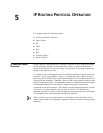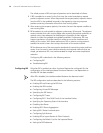
Static Routes 67
main route. When the line fails, the main route hides itself and the router chooses
one from the remaining routes as a backup route whose precedence is higher than
others' to send data. When the main route recovers, the router restores it and
re-selects a route. As the main route has the highest precedence, the router
chooses the main route to send data. This process is the automatic switchover
from the backup route to the main route.
For the same destination, a specified routing protocol may find multiple different
routes. If the routing protocol has the highest precedence among all active routing
protocols, these multiple routes will be regarded as currently valid routes. Thus,
load sharing of IP traffic is ensured in terms of routing protocols. The Switch 8800
supports four routes to implement load sharing.
Routes Shared Between Routing Protocols
As the algorithms of various routing protocols are different, different protocols can
generate different routes. This situation creates the problem of how to resolve
different routes being generated by different routing protocols. The Switch 8800
supports an operation to import the routes generated by one routing protocol into
another routing protocol. Each protocol has its own route redistribution
mechanism. For details, refer to
“Enabling RIP to Import Routes of Other
Protocols”, “Configuring OSPF to Import the Routes of Other Protocols”, or
“Importing Routing Information Discovered by Other Routing Protocols”.
Static Routes A static route is a route that is manually configured by the network administrator.
You can set up an interconnected network using static routes. However, if a fault
occurs in the network, the static route cannot change automatically to steer
packets away from the fault without the help of the administrator.
In a relatively simple network, you only need to configure static routes to make the
router work normally. The proper configuration and usage of the static route can
improve network performance and ensure bandwidth for important applications.
The following routes are static routes:
■ Reachable route — The normal route in which the IP packet is sent to the next
hop towards the destination. It is a common type of static route.
■ Unreachable route — When a static route to a destination has the reject
attribute, all the IP packets to this destination are discarded, and the originating
host is informed that the destination is unreachable.
■ Blackhole route — When a static route to a destination has the blackhole
attribute, all the IP packets to this destination are discarded, and the originating
host is not informed.
The attributes reject and blackhole are usually used to control the range of
reachable destinations of this router, and to help troubleshoot the network.
Default Route
A default route is also a static route. A default route is used only when no suitable
routing table entry is found. In a routing table, the default route is in the form of
the route to the network 0.0.0.0 (with the mask 0.0.0.0). You can determine
whether a default route has been set by viewing the output of the display ip
routing-table command. If the destination address of a packet fails to match any


















